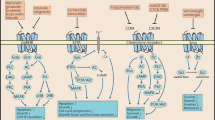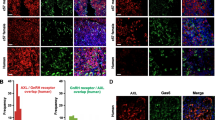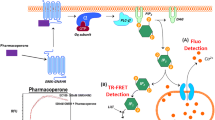Abstract
As the continuation of a previous study, synthetic peptides corresponding to the extracellular domains of human gonadotropin-releasing hormone (GnRH) receptor were used to generate additional monoclonal antibodies which were further characterized biochemically and immunologically. Among those identified to recognize GnRH receptor, monoclonal antibodies designated as GHR-103, GHR-106 and GHR-114 were found to exhibit high affinity (Kd ≤ 1 × 10−8 M) and specificity to GnRH receptor as judged by the whole cell binding immunoassay and Western blot assay. Both anti-GnRH receptor monoclonal antibodies and GnRH were shown to compete for the same binding site of GnRH receptor on the surface of cultured cancer cells. Growth inhibitions of cancer cells cultured in vitro were demonstrated by cellular apoptosis experiments (TUNEL and MTT assays) under different conditions of treatment with GHR-106 monoclonal antibody or GnRH analogs. It was generally observed that both GnRH I and GHR-106 effectively induce the apoptosis of cultured cancer cells as determined by TUNEL and MTT assays. Consistently, suppressions of gene expressions at mRNA levels were demonstrated with several ribosomal proteins (P0, P1, P2 and L37), when cancer cells were incubated with GnRH or GHR-106. The widespread expressions of GnRH receptor in almost all of the studied human cancer cell lines were also demonstrated by RT-PCR and Western blot assay, as well as indirect immunofluorescence assay with either of these monoclonal antibodies as the primary antibody. In view of the longer half life of antibodies as compared to that of GnRH or its analogs, anti-GnRH receptor monoclonal antibodies in humanized forms could function as GnRH analogs and serve as an ideal candidate of anti-cancer drugs for therapeutic treatments of various cancers in humans as well as for fertility regulations.





Similar content being viewed by others
Abbreviations
- ELISA:
-
Enzyme-linked immunosorbent assay
- FITC:
-
Fluorescein isothiocyanate
- GAPDH:
-
Glyceraldehyde phosphate dehydrogenase
- GnRH I:
-
Type I gonadotropin-releasing hormone (a decapeptide: pGlu-His-Trp-Ser-Tyr-Gly-Leu-Arg-Pro-Gly-NH2)
- IIF:
-
Indirect immunofluorescence
- Mab:
-
Monoclonal antibody
- MTT:
-
3-(4,5-Dimethylthiazol-2-yl)-2,5-diphenyltetrazolium bromide
- p-GnRHR:
-
A synthetic peptide corresponding to N1–29 amino acid residues in the extracellular domain of human GnRH receptor
- KLH:
-
Keyhole limpet hemocyanin
- TUNEL:
-
Terminal deoxynucleotidyl transferase dUTP nick end labeling
References
Clayton RN (1989) Gonadotropin-releasing hormone: its action and receptors. J Encrinol 120:11–19
Lee GCY, Ho J, Chow SN, Yasojima K, Schwab C, McGeer PL (2000) Immunoidentification of gonadotropin releasing hormone receptor in human sperm, pituitary and cancer cells. Am J Reprod Immunol 44:170–177
Chien CH, Chen CH, Lee CYG, Chang TC, Chen RJ, Chow SN (2004) Detection of gonadotropin-releasing hormone receptor and its mRNA in primary human epithelial ovarian cancers. Int J Gynecol Cancer 14:451–458
Kang SK, Choi K-C, Yang H-S, Leung PCK (2003) Potential role of gonadotrophin-releasing hormone (GnRH)-I and GnRH-II in the ovary and ovarian cancer. Endocr Relat Cancer 10:169–177
Choi J-H, Gilks CB, Auersperg N, Leung PCK (2006) Immunolocalization of gonadotropin-releasing hormone GnRH-I, GnRH-II, and Type I GnRH receptor during follicular development in the human ovary. J Clin Endocrinol Metab 91:4562–4570
So W-K, Cheng J-C, Poon S-L, Leung PCK (2008) Gonadotropin-releasing hormone and ovarian cancer: a functional and mechanistic overview. FEBS J 275:5496–5511
Chen A, Kaganovsky E, Rahimipour S, Ben-Aroya N, Okon E, Koch Y (2002) Two forms of gonadotropin-releasing hormone (GnRH) are expressed in human breast tissue and overexpressed in breast cancer: a putative mechanism for the antiproliferative effect of GnRH by down-regulation of acidic ribosomal phosphoproteins P1 and P2. Cancer Res 62:1036–1044
Pati D, Habibi HR (1995) Inhibition of human heptocarcinoma cell proliferation by mammalian and fish gonadotropin releasing hormones. Endocrin 136:75–84
Choi KC, Auersperg N, Leung PCK (2001) Expression and anti-proliferative effect of a second form of gonadotropin-releasing hormone in normal and neoplastic ovarian surface epithelial cells. J Clin Endocrinol Metab 86:5075–5078
Marelli MM, Moretti RM, Mai S, Januszkiewicz-Caulier J, Motta M, Limonta P (2009) Type I gonadotropin-releasing hormone receptor mediates the antiproliferative effects of GnRH-II on prostate cancer cells. J Clin Endocrinol Metab 94:1761–1767
Tsai N-M, Hsieh R-H, Au H-K, Shieh M-J, Huang S-Y, Tzeng C-R (2005) Effects of gonadotrophin-releasing hormone agonist on apoptosis of granulose cells. Ann N Y Acad Sci 1042:531–537
Nagy A, Schally AV (2005) Targeting of cytotoxic luteinizing hormone-releasing hormone analogs to breast, ovarian, endometrial, and prostate cancers. Biol Reprod 73:851–859
Szepeshazi K, Schally AV, Treszi A, Seitz S, Halmos G (2008) Therapy of experimental hepatic cancers with cytotoxic peptide analogs targeted to receptors for luteinizing hormone-releasing hormone, somatostatin or bombesin. Anti Cancer Drugs 19:349–358
Stangelberger A, Schally AV, Djavan B (2008) New treatment approaches for prostate cancer based on peptide analogues. Eur Urol 53:890–900
Emons G, Gruendker C, Guenthert AR, Westphalen S, Kavanagh J, Verschraegen C (2003) GnRH antagonists in the treatment of gynecological and breast cancers. Endocr Relat Cancer 10:291–299
Gnananpragasam VJ, Darby S, Khan MM, Lock WG, Robson CN, Leung HY (2005) Evidence that prostate gonadotropin-releasing hormone receptors mediate an anti-tumourigenic response to analogue therapy in hormone refractory prostate cancer. J Pathol 206:205–213
Choi J-H, Choi K-C, Auersperg N, Leung PCK (2006) Differential regulation of two forms of gonadotropin-releasing hormone messenger ribonucleic acid by gonadotropins in human immortalized ovarian surface epithelium and ovarian cancer cells. Endocr Relat Cancer 13:641–651
Weckermann D, Harzmann R (2004) Hormone therapy in prostate cancer: LHRH antagonists versus LHRH analogues. Eur Urol 46:279–284
Huhtaniemi L, White R, McArdle CA, Persson B-E (2008) Will GnRH antagonists improve prostate cancer treatment? Trends Endocrinol Met 20:43–50
Reichert J, Pavlou A (2004) Monoclonal antibodies market. Nat Rev Drug Discov 3:383–384
Takimoto CH, Calvo E (2008) Principles of oncologic pharmacotherapy. In: Pazdur R, Wagman LD, Camphausen KA, Hoskins WJ (eds) Cancer management: a multidisciplinary approach, 11th edn. http://www.cancernetwork.com/web/10165. Accessed April 2009
Karande AA, Rajeshwari K, Schol DJ, Hilgers JHM (1995) Establishment of immunological probes to study human gonadotropin-releasing hormone receptors. Mol Cell Endocrinol 114:51–56
Rajeshwari K, Karande AA (1999) Molecular mimicry by antidiotypic monoclonal antibody to gonadotropin releasing hormone. Immunol Invest 28:103–114
Asirvatham AL, Johnson GA, Belden EL, Van Kirk EA, Moss GE, Murdoch WJ (1994) Immunization of mice against a synthetic N-terminal extracellular domain Gonadotropin-releasing hormone receptor peptide: evidence for a direct uterine effect. Am J Reprod Immunol 32:95–100
Ackerman RC, Johnson GA, Van Kirk EA, Asirvatham AL, Murdoch WJ (1994) Induction of apoptotic or lytic death in an ovarian adenocarcinoma cell line by antibodies generated against a synthetic N-terminal extracellular domain gonadotropin-releasing hormone receptor peptide. Cancer Lett 81:177–184
Lee CYG, Chen KW, Sheu FS, Tsang A, Chao KC, Ng HT (1992) Studies of a tumor- associated antigen, COX-1, recognized by a monoclonal antibody. Cancer Immunol Immunother 35:19–26
Lee CYG, Wong E, Richter DE, Menge AL (1984) Monoclonal antibodies to human sperm antigens II. J Reprod Immunol 6:227–238
Freed KA, Brennecke SP, Moses EK (2005) Gene expression of the constant region of the heavy chain of immunoglobulin G is down-regulated in human decidua in association with preeclampsia. J Reprod Immunol 68:105–120
Rozsa B, Juhasz A, Treszl A, Toth G, Flasko T, Dezso B, Block N, Schally A, Halmos G (2009) Expression of mRNA for human type-I LHRH receptor transcript forms in human benign prostatic hyperplasia. Int J Oncol 35:1053–1059
Gruendker C, Voelker P, Schulz K-D, Emons G (2000) Luteinizing hormone-releasing hormone agonist triptorelin and antagonist cetrorelix inhibit EGF-induced c-fos expression in human gynecological cancers. Gynecol Oncol 78:194–202
Chi L, Zhou W, Golembo M, Illing N, Millar RP, Sealfon SC (1993) Cloning and characterization of the human GnRH receptor. Mol Cell Endocrinol 91:R1–R6
Margolin K, Gordon MS, Holmgran E, Gaudreault J, Novotny W, Fyfe G, Adelman D, Stalter S, Breed J (2001) Phase I safety and pharmacokinetic study of recombinant human anti-vascular endothelial growth factor in patients with advanced cancer. J Clin Oncol 19:851–856
Periti P, Mazzei T, Mini E (2002) Clinical pharmacokinetics of depot Leuprorelin. Clin Pharmacokin 41:485–504
Acknowledgments
The Industry R&D Fellowship (IRDF, #360647) from NSERC (Natural Sciences and Engineering Research Council of Canada) to BG was acknowledged. This project was supported in parts by Vancouver Biotech Ltd (#080201). The NSERC and IRAP support of the following co-op students and research assistants are also acknowledged: C. Zhang, D.Tsui, E. Laflamme, A. Spreeuw and K. Huang. Proof reading of this manuscript by I. Wang is acknowledged.
Conflict of interest statement
GL is co-founder of Vancouver Biotech Ltd.
Author information
Authors and Affiliations
Corresponding author
Rights and permissions
About this article
Cite this article
Lee, G., Ge, B. Growth inhibition of tumor cells in vitro by using monoclonal antibodies against gonadotropin-releasing hormone receptor. Cancer Immunol Immunother 59, 1011–1019 (2010). https://doi.org/10.1007/s00262-010-0823-3
Received:
Accepted:
Published:
Issue Date:
DOI: https://doi.org/10.1007/s00262-010-0823-3




